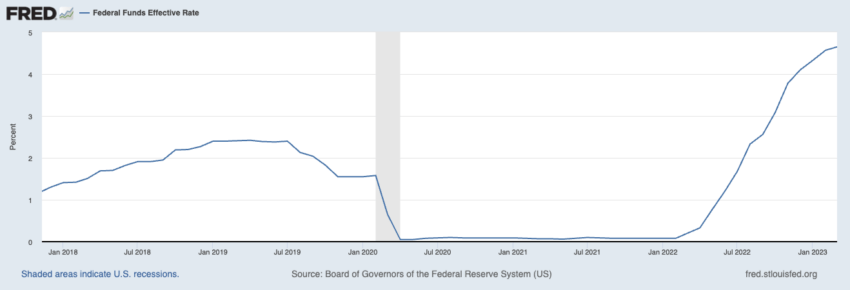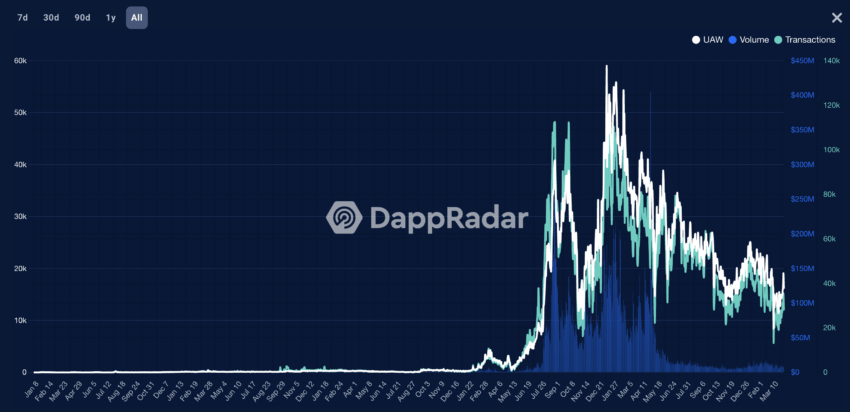NFT Market Slumps as Crypto Investors Cut Back on Spending

The extravagant realm of trading high-priced assets has expanded beyond the exclusive domain of art connoisseurs and into the crypto industry. Amid the boom, many investors have turned their attention to global art, NFTs, and luxury items like Rolex watches.
Still, as economic growth begins to decelerate, the luxury goods market is experiencing a similar downturn.
Global Art Sales Take a Hit
According to the Washington Post, global art sales reached $67.8 billion in 2022, marking a 3% increase from the previous year. In contrast, 2021 witnessed a 30% surge in art sales compared to 2020. The influx of $9 trillion in liquidity has undoubtedly played a significant role in bolstering the art market.
The United States has been a primary driver of the art market, with iconic pieces such as Andy Warhol’s Shot Sage Blue Marilyn selling for $195 million and Leonardo Da Vinci’s Salvator Mundi fetching $450 million in 2017.
However, the market began to lose steam in late 2022. Waning demand for lower-end work, concerns about recession, rampant inflation, and rising interest rates have severely impacted this market.

U.S. Federal Funds Effective Interest Rate. Source: FRED
In addition to these factors, younger luxury consumers are also cutting back on spending.
Brands like Burberry Group Plc and Gucci-owner Kering SA report that “aspirational buyers” – a younger demographic – are becoming more cautious with their expenditures as we head into 2023.
NFT Sales Suffer, But China May Hold the Key
The decline in market enthusiasm is most evident in the NFT space. After skyrocketing from $20 million in sales in 2020 to $2.9 billion in 2021, art-related NFT sales dropped by approximately 50% in 2022.
While young people continue to invest in art, those who do typically possess over $1 million in assets, including real estate and private businesses. This distinguishes them from the “crypto bros” who entered the market during the boom.

OpenSea Historical Activity. Source: DappRadar
The Washington Post suggests that China may hold the key to revitalizing the art and luxury markets. Following the 2008 financial crisis, the Chinese market played a crucial role in the recovery. Art sales bounced back in 2010.
Recent events like Art Basel Hong Kong and positive signals from brands such as Prada and Moncler indicate a resurgence in luxury shopping. Bernstein analysts have also observed Chinese fashion enthusiasts beginning to travel abroad once more.
For purveyors of high-end products from Balenciaga to Basquiat, the hope is that Chinese consumers will unleash a new wave of “revenge spending” to revitalize the luxury and alternative asset markets.







 Bitcoin
Bitcoin  Ethereum
Ethereum  Tether
Tether  USDC
USDC  Dogecoin
Dogecoin  Cardano
Cardano  TRON
TRON  Bitcoin Cash
Bitcoin Cash  Chainlink
Chainlink  Polygon
Polygon  Litecoin
Litecoin  LEO Token
LEO Token  Dai
Dai  Ethereum Classic
Ethereum Classic  Hedera
Hedera  Cosmos Hub
Cosmos Hub  Cronos
Cronos  Stellar
Stellar  Stacks
Stacks  OKB
OKB  Maker
Maker  Monero
Monero  Theta Network
Theta Network  Algorand
Algorand  Gate
Gate  NEO
NEO  KuCoin
KuCoin  EOS
EOS  Tezos
Tezos  Synthetix Network
Synthetix Network  IOTA
IOTA  Bitcoin Gold
Bitcoin Gold  Tether Gold
Tether Gold  TrueUSD
TrueUSD  Zilliqa
Zilliqa  Enjin Coin
Enjin Coin  Ravencoin
Ravencoin  Holo
Holo  Siacoin
Siacoin  0x Protocol
0x Protocol  Qtum
Qtum  Basic Attention
Basic Attention  Zcash
Zcash  Dash
Dash  NEM
NEM  Decred
Decred  Ontology
Ontology  Lisk
Lisk  Waves
Waves  DigiByte
DigiByte  Numeraire
Numeraire  Status
Status  Nano
Nano  Pax Dollar
Pax Dollar  Hive
Hive  Steem
Steem  Huobi
Huobi  OMG Network
OMG Network  BUSD
BUSD  Ren
Ren  Bytom
Bytom  Bitcoin Diamond
Bitcoin Diamond  Kyber Network Crystal Legacy
Kyber Network Crystal Legacy  Augur
Augur  Energi
Energi  HUSD
HUSD